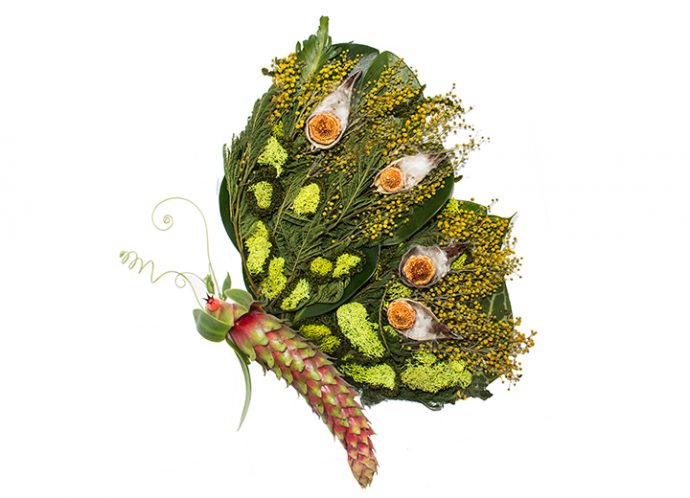They’re as apparent as fashion and as profound as death itself.
They alight for a moment, flitting from flower to flower and yet are capable in some cases of traveling great distances.
They’re tiny, gossamer things, vulnerable to predators and yet powerful in their deception to elude those predators and perpetuate their species.
They’re some 40 million years old and yet live for no more than nine months. And while their time on this earth is poignantly brief, they’re immortal in art and memory.
Butterflies are contradictory creatures, much like us. Perhaps that’s why we like them so. Then, too, they are harbingers of the yearned-for spring, particularly after this winter. Indeed, The New Yorker optimistically featured a big butterfly – with glamorous leopard-print wings, no less – on the cover of its March 24 issue, a mere four days after the calendar, if not the temps, turned to the gentler season.
Still, it always seems to be the time of the butterfly, doesn’t it? From the David Nelson metal sculptures on the cover of Neiman Marcus’ April book to MacKenzie-Childs’ new Butterfly Garden enamelware to Van Cleef & Arpels’ Two Butterfly Between the Finger ring of diamonds and yellow sapphires to Puccini’s “Madama Butterfly” – which The Metropolitan Opera is presenting through May 9 – butterflies flutter through the mind and imagination to find a permanent resting place in the heart.
But just because we love them so doesn’t mean we always understand them. We might, for instance, think of them as the colorful cousins of the drab moth. No, no, no, says David Grimaldi, curator in the American Museum of Natural History’s Division of Invertebrate Zoology. He’s also curator of the museum’s “Butterfly Conservatory,” an exhibit in its 16th year that has been extended through June 22 and that features 500 butterflies, including monarchs, zebra longwings, paper kites, blue morphos, scarlet swallowtails and green birdwings, among other species. (There are 8,000 species of butterflies worldwide.)
Grimaldi’s interest in butterflies comes from his study of moths, of which butterflies are types, having evolved as brightly colored variations of the inchworm moth.
Another misconception: While monarchs are famed frequent fliers, what you’re seeing in PBS’ 2009 documentary “The Incredible Journey of the Butterflies” is a generational migration, Grimaldi says, as one group dies off and others are born en route from Canada to Mexico in what can be described as the insect equivalent of snow-birding in Boca Raton.
Butterflies are pollinators, doing their thing on behalf of the birds and the bees (and the butterflies) as they flit from flower to flower, drinking up nectar with their distinctive noses. Despite their delicacy, they’re quite the little gourmands, if not gourmets, also feasting – particularly in the tropics – on dung, rotted fruit and even carcasses, making excellent use of their long, coiled, studded tongues. If you find butterflies alighting on you in The Butterfly Conservatory’s 1,200-square-foot vivarium, it may be because they think you’re hot – literally. Butterflies need salt, so they like water, whether it be from a birdbath, a puddle, human perspiration or urine. So don’t mind if they make a pit stop on your glistening body. It’s a good thing – or not, depending on what folklore you listen to. More on that in a bit.
Like us, then, butterflies have what Grimaldi calls “excellent sensory modalities” – sharp eyesight, great taste buds and a keen sense of smell. And like us, they’re not averse to showing off, adapting vivid hues and patterns to mimic other insects and plants, advertise their toxicity to potential predators and, in the case of the male, attract Ms. Butterfly for a little amour. It’s a sweet life of nectar, pollination and procreation, but one that is increasingly threatened by a loss of habitat resulting from herbicides and pesticides.
“We haven’t lost any species, but the populations have declined,” he says.
Among the endangered species are the monarchs as well as the tiny, less adaptable bog elfin and Karner blue butterflies, which have very specific habitats.
Another problem is butterflies emerging too early and then being blindsided by storms and snow. Increasingly, butterflies are found farther north and at higher elevations, and that, Grimaldi says, is absolutely the result of climate change.
One place where the butterfly will find the perfect habitat is the Native Plant Garden, a 3.5-acre site within The New York Botanical Garden that’s celebrating the one-year anniversary of a contemporary redesign to focus on indigenous vegetation of the Northeast. There’s a 230-foot water feature along with plenty of milkweed, Joe-pye weed, buddleja (butterfly bush), rhododendron and, in summer, dusky rose for butterflies to feed on. Milkweed is also known as asclepias, after Asclepius, the Greco-Roman god of healing – the milky substance having been used as medicine. It’s actually toxic, says Brian Sullivan, The Botanical Garden’s vice president for landscaping, outdoor collections and gardens. But rather than harming butterflies, it enables them through coloration to let predators know that you can look, but you better not touch.
Whether you’re enjoying the elusive beauties at The Garden or in the Museum of Natural History’s Butterfly Conservatory and extensive collections of specimens, you’ll be experiencing colors and patterns that Grimaldi says are incomparable. But that hasn’t stopped artists and artisans going back to ancient Egypt and Mexico from trying to equal them. The naturalist and botanical illustrator Maria Sibylla Merian chronicled the butterfly’s odyssey from larva to pupa/chrysalis to maturity in “Metamorphosis insectorum Surinamensium” (1705), a seminal book of hand-colored copper engravings. Some 200 years later, American Loïe Fuller captured Paris’ high society with dances and costumes that evoked the butterfly’s flickering movements.
Today, the versatile insect is a go-to fashion accessory and home design accent, as seen in Scully & Scully’s “Papillon II” tray; Rejuvenation’s butterfly door knocker; the Tiffany Blue Book 2014 brooch of blue chalcedony, Montana sapphires, moonstones and diamonds; Sophia Webster’s leather boots of towering cutouts; Ovvo’s titanium and fused surgical steel sunglasses, with their winged temples; and Thale Blanc’s butterfly-kissed Plexiglas and gold brass clutch.
But to understand the butterfly as metaphor in the deepest sense you have to look to the arts. There it is the symbol of yearned-for freedom (the Steve McQueen prison movie “Papillon,” Vincent van Gogh’s “Prisoners in the Courtyard”) while its metamorphosis becomes the framework for love’s oft-tragic trajectory.
In Puccini’s “Madama Butterfly,” the innocent young geisha Cio-Cio San (chocho sahn) is transformed from blossoming bride to proud wife and mother to despairing suicide, betrayed by her faithless American lover and her deluded quest to be a modern American woman. Puccini knew his Japanese folklore. In Japan, the butterfly (cho) represents the soul and can be, as it is throughout the Far East, a portent of good or evil.
David Henry Hwang’s play “M. Butterfly” offers a transgender-bending variation on Puccini’s theme as a French diplomat falls for a cross-dressing Chinese Opera singer and finds himself echoing Cio-Cio San’s end when he realizes that the singer he loved is really a man and a spy.
Not all metamorphoses end badly, however. The ancient Greek word for butterfly is “psyche,” which happens to be the name of the naïve beauty beloved by the god of love himself, Eros (Cupid). But Psyche can’t leave well enough alone. (A meddlesome mama-in-law, Aphrodite, and jealous sisters don’t help.)
Psyche goes through hell itself to win back Cupid, but win him back she does. The 18th-century sculptor Antonio Canova gives us the touching ending in a turn-of-the-19th century marble. As Cupid and Psyche embrace – heads touching, tendrils of hair caressing their delicate necks – she holds a butterfly gently by its wings in his hand.
The butterfly – the soul – has come to rest at last in the palm of love.





